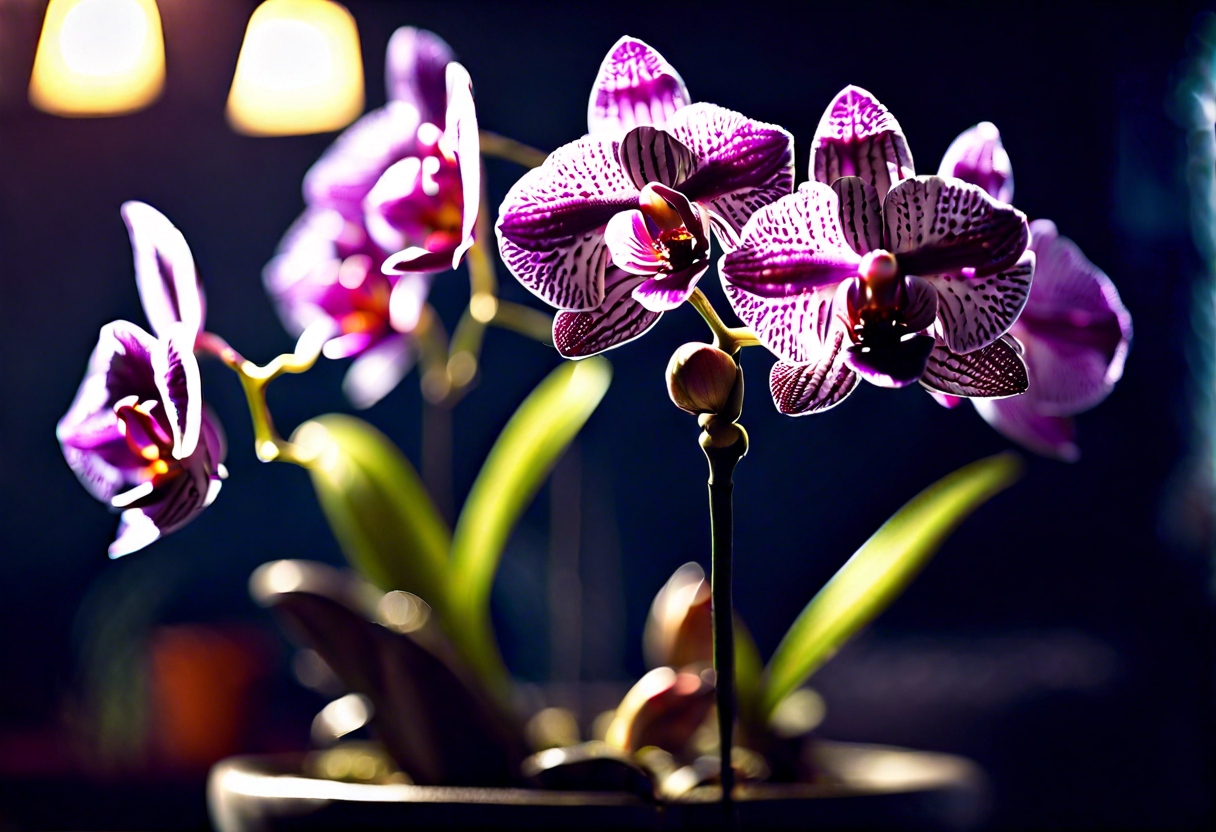Proper Watering Techniques for Orchids After Bloom Care
After the orchid blooms have faded, proper watering techniques are crucial to ensure the plant’s continued health and vitality. Orchids are unique plants that require specific care, and understanding their watering needs is essential for their post-bloom care.
One of the most important aspects of watering orchids is to avoid overwatering. Orchids are epiphytic plants that naturally grow on trees, and their roots are adapted to absorb water from the air. This means that they don’t tolerate standing water around their roots, which can lead to root rot and other fungal diseases.
Instead, it is recommended to water orchids thoroughly and then allow the potting medium to dry out slightly before watering again. This mimics their natural habitat where heavy rains are followed by dry periods. One effective watering technique is the “soak and dry” method.
To perform the “soak and dry” method, place the orchid in a sink or a basin and water it until the water runs freely through the drainage holes. Ensure that the entire potting medium is thoroughly saturated. After watering, allow the orchid to drain completely before returning it to its regular spot.
It’s important to note that the frequency of watering will vary depending on various factors, including the type of orchid, the potting medium used, and the environmental conditions. As a general guideline, most orchids need to be watered about once a week, but you should always check the moisture level of the potting medium before watering.
In addition to proper watering techniques, humidity is also crucial for the post-bloom care of orchids. Most orchids thrive in high humidity environments, with levels around 50-70%. You can increase humidity by placing a tray filled with water and pebbles under the orchid pot or by using a humidifier.
Remember to monitor the orchid closely during the post-bloom period and adjust your watering routine accordingly. Observing the plant’s leaves and potting medium will provide valuable indicators of its hydration needs. With proper watering techniques and attention to humidity levels, your orchid will remain healthy and ready to bloom again in the future.
Adjusting Light Conditions for Orchids After Blooming
Proper light conditions are essential for the health and growth of orchids, especially after they have finished blooming. Adequate light exposure ensures that the orchid can continue to photosynthesize and produce energy for new growth. However, it is crucial to adjust the light conditions appropriately, taking into account the specific needs of each orchid variety.
1. Provide indirect sunlight: Most orchids prefer bright, indirect light rather than direct sunlight. Placing them near a north or east-facing window is ideal. This way, they receive enough light without being exposed to the harsh, drying effects of direct sunlight.
2. Observe the leaves: The color of the orchid’s leaves can serve as an indicator of whether they are receiving the correct amount of light. Dark green leaves may suggest that the orchid is not receiving enough light and may require more exposure. Conversely, leaves that turn yellow or develop sunburn spots may indicate that the orchid is receiving too much light and needs to be moved to a shadier spot.
3. Consider the orchid’s natural habitat: Different orchid species originate from various environments, and it is essential to replicate those conditions as closely as possible. For example, orchids that naturally grow in tropical forests may require more shade, while those from higher elevations may prefer brighter light. Research the specific light requirements of your orchid species to provide the best conditions.
4. Use supplementary lighting: In situations where natural light is insufficient, you can supplement it with artificial lighting. LED grow lights are a popular choice as they emit the right spectrum of light for orchid growth. Position the lights above the orchids, ensuring they are at the correct distance for optimal absorption.
5. Gradually acclimate to new conditions: If you need to move your orchid to a new location with different light conditions, do so gradually. Sudden changes in light exposure can stress the plant and lead to leaf damage. Start by moving the orchid to a slightly brighter or shadier area, then gradually increase or decrease the light over a period of weeks.
Remember that orchids are individualistic plants, and their light requirements can vary. It is crucial to observe your orchid’s response and make adjustments accordingly. By providing the right amount of light and adjusting it appropriately after blooming, you can ensure the continued health and growth of your orchids.
Temperature and Humidity Levels Required for Post-Bloom Orchid Care
Creating the Ideal Environment for Post-Bloom Orchid Care
After the vibrant blooms of your orchids have faded, proper care and attention is crucial for maintaining their health and encouraging future growth. One of the key factors in providing optimal post-bloom care for orchids is creating the right temperature and humidity levels. Orchids are delicate plants that thrive in specific conditions, and understanding their temperature preferences and humidity requirements is essential for their continued well-being.
Temperature
Orchids are known for their ability to adapt to various temperature ranges, depending on the specific species. However, for most orchids, a temperature range of 65°F to 75°F (18°C to 24°C) during the day and slightly cooler temperatures of 60°F to 65°F (15°C to 18°C) during the night is ideal. It is important to avoid extreme temperature fluctuations, as orchids are sensitive to sudden changes.
During the post-bloom period, it is advisable to maintain a relatively stable temperature for your orchids. This can be achieved by placing them in a location away from drafts or temperature extremes, such as vents or direct sunlight. If necessary, consider using a small fan or heater to regulate the temperature in the area where your orchids are kept.
Humidity
Orchids thrive in environments with high humidity levels, as they naturally grow in tropical regions. Providing adequate humidity is crucial for their overall health and well-being, especially during the post-bloom phase. Aim for a humidity level of around 50% to 70% to simulate their native habitat.
To increase humidity, there are several methods you can employ. One simple technique is to place a tray filled with water near your orchids. As the water evaporates, it will raise the humidity in the vicinity. Alternatively, you can use a humidifier specifically designed for plants, particularly if you have a larger collection of orchids. Mist your orchids regularly using a fine spray bottle to provide additional moisture.
It is important to note that maintaining proper humidity levels is particularly crucial during the winter months when indoor heating can lead to dry air. Regularly monitor the humidity levels and adjust your methods accordingly to ensure your orchids receive the necessary moisture they require after blooming.
Providing the appropriate temperature and humidity levels is vital for the post-bloom care of your orchids. Understanding the specific temperature preferences of your orchid species and maintaining a stable environment will contribute to their overall health and growth. Additionally, ensuring adequate humidity levels will help replicate their natural tropical habitat, promoting their well-being. By implementing these tips, you can continue to enjoy the beauty and vitality of your orchids long after their blooms have faded.
Tips for Fertilization to Encourage New Growth in Orchids After Flowering
Orchids are prized for their stunning flowers, but once they finish blooming, it’s important to provide proper care to encourage new growth. Fertilization plays a crucial role in promoting healthy orchid growth after flowering. With the right techniques, you can ensure that your orchids continue to thrive and produce beautiful blooms year after year.
1. Choose the Right Fertilizer
When it comes to fertilizing orchids, it’s essential to select a fertilizer specifically formulated for these delicate plants. Look for a balanced orchid fertilizer that contains a ratio of nitrogen (N), phosphorous (P), and potassium (K). These macronutrients are vital for supporting overall plant growth, root development, and flower production.
2. Follow a Regular Fertilization Schedule
Establishing a consistent fertilization schedule is crucial for the after-bloom care of orchids. Most experts recommend fertilizing orchids every two weeks during the growing season, which typically lasts from spring to fall. Be sure to adjust this schedule based on the type of fertilizer you’re using and follow the product instructions for optimal results.
3. Dilute the Fertilizer
Orchids have delicate root systems that can be easily damaged by concentrated fertilizers. To prevent the risk of burning or stressing the roots, it’s important to dilute the fertilizer appropriately. Follow the label instructions to determine the recommended dilution ratio based on the strength of the fertilizer you’re using.
4. Apply Fertilizer During Watering
One effective technique for fertilizing orchids is to incorporate the fertilizer into their regular watering routine. Mix the dilute fertilizer in water and use it to thoroughly moisten the potting medium. This helps distribute the nutrients evenly to the orchid’s root system and ensures proper absorption.
5. Monitor the Plant’s Response
While fertilization is essential for encouraging new growth in orchids, it’s crucial to monitor the plant’s response to avoid over or under-fertilization. Signs of over-fertilization include root or leaf burn, stunted growth, or a buildup of salt deposits on the potting medium’s surface. If you notice any of these signs, adjust the fertilization amount or frequency accordingly.
6. Flush the Potting Medium
To prevent salt buildup and nutrient imbalances in the potting medium, occasionally flush the orchid’s container with plain water. This process helps remove any excess salts or residues that can accumulate over time. Flushing also ensures that the orchid’s roots can efficiently absorb the nutrients they need for healthy growth.
Fertilization is a crucial aspect of post-bloom orchid care that promotes strong growth and prepares the plant for future blooms. By choosing the right fertilizer, following a regular schedule, diluting appropriately, and monitoring the plant’s response, you can provide optimal fertilization and encourage healthy new growth in your orchids. With proper care, your orchids will thrive and delight you with their stunning blossoms for years to come.
Pruning and Trimming Strategies for Maintaining Healthy Orchids After Blooming
Orchids are delicate and beautiful flowers that require proper care and attention, especially after they have finished blooming. Pruning and trimming your orchids is a crucial step in maintaining their health and promoting new growth. In this article, we will discuss some strategies for pruning and trimming orchids to ensure their vitality and longevity.
When it comes to pruning orchids, timing is essential. It is best to wait until the flower spike has completely withered before pruning. This allows the orchid to redirect its energy towards new growth rather than wasting it on dying flowers. Carefully examine the stem, and if it is brown and dried out, you can safely remove it by cutting it at the base using clean, sterilized pruning shears.
Another important aspect of pruning orchids is removing old, dead or damaged leaves. These leaves not only detract from the overall appearance of the plant but can also harbor pests or diseases. Gently pull the damaged leaves away from the plant, being careful not to damage the healthy ones. If necessary, you can also use sterilized scissors to trim away any brown or yellowing portions of the leaves.
Most orchids have aerial roots that are exposed to the air rather than being buried in the soil like traditional plant roots. These roots play a vital role in nutrient absorption and should not be cut or pruned. However, if you notice any dead or shriveled roots, you can remove them by cutting them close to the base using sterilized scissors. This will allow the plant to focus its energy on developing healthy new roots.
After pruning your orchids, it is important to provide them with the necessary post-trim care. One crucial step is to apply a fungicide or cinnamon powder on the cut edges to prevent infections. This will protect your orchid from potential diseases and ensure proper healing. Additionally, it is advisable to keep your orchids in a clean and well-ventilated area after pruning to avoid any chances of fungal or bacterial infections.
Regular pruning and trimming of orchids promote better air circulation and light penetration, leading to healthier and more robust growth. Trimming also encourages the development of new shoots and spikes, resulting in a more abundant and vibrant display of flowers. By following these pruning strategies and caring for your orchids after they have bloomed, you can ensure that they remain healthy and continue to thrive for years to come.
Conclusion
The after bloom care of orchids is crucial to ensure their continued health and future blossoming. Proper watering techniques play a vital role in maintaining orchids after their flowering period. It is essential to strike a balance between providing enough moisture for the roots without overwatering, which can lead to root rot. By allowing the potting medium to dry slightly between watering sessions, orchid owners can prevent waterlogged soil and promote healthy root growth.
Another crucial aspect of after bloom care is adjusting the light conditions for orchids. After flowering, it is recommended to provide indirect sunlight or filtered light to prevent excessive exposure that could harm the delicate orchid. Placing them near a window with a sheer curtain or using artificial growing lights can help replicate the ideal lighting conditions. Monitoring the leaves for any signs of sunburn or damage can indicate if adjustments are necessary.
Temperature and humidity levels are also instrumental in caring for orchids after flowering. These delicate plants thrive in warm and humid environments, so maintaining suitable conditions is vital. The average temperature range of 65-80°F (18-27°C) during the day and around 55-65°F (13-18°C) at night is ideal for most orchid varieties. Additionally, using humidifiers or placing the pots over trays filled with water and pebbles can provide the necessary humidity levels to simulate the natural habitat.
Fertilization is an essential aspect of promoting new growth in orchids after flowering. Using a balanced orchid fertilizer, specifically formulated to meet their nutritional requirements, can provide the necessary nutrients to encourage healthy foliage and root development. It is recommended to follow the instructions provided by the manufacturer and apply the fertilizer at regular intervals to avoid overfertilization, which could damage the plants.
Pruning and trimming strategies are crucial for maintaining healthy orchids after blooming. Removing spent flowers and trimming back any dead or yellowing leaves prevents the growth of diseases and allows the plant to redirect energy towards new growth. Moreover, pruning can help maintain the desired shape and size of the orchid, promoting better airflow and preventing overcrowding of the foliage.
By following these after bloom care tips for orchids, enthusiasts can ensure their plants remain healthy and vibrant even after the blooming period. Orchids are known for their beauty and elegance, and with proper care, they can continue to thrive year after year, rewarding their owners with stunning displays of blossoms. Remember to adjust watering techniques, light conditions, temperature, and humidity levels accordingly, provide appropriate fertilization, and maintain regular pruning to enjoy the beauty of orchids long after they bloom.


